
Features
Structural
Training
Back to Basics – December 2012
This month’s topic pertains to fire departments that serve buildings with either single or multiple standpipe systems. A standpipe system is defined by NFPA 14 as: “An arrangement of piping, valves, hose connections and allied equipment installed in a building or structure, with the hose connections located in such a manner that water can be discharged in streams through attached hose and nozzles, for the purposes of extinguishing a fire, thereby protecting a building or structure and its contents in addition to protecting the occupants. This is accomplished by means of connections to water supply systems or by means of pump tanks and other equipment necessary to provide an adequate supply of water to the hose connections (NFPA, 2003).”
November 22, 2012
By Mark Van Der Feyst
This month’s topic pertains to fire departments that serve buildings with either single or multiple standpipe systems. A standpipe system is defined by NFPA 14 as: “An arrangement of piping, valves, hose connections and allied equipment installed in a building or structure, with the hose connections located in such a manner that water can be discharged in streams through attached hose and nozzles, for the purposes of extinguishing a fire, thereby protecting a building or structure and its contents in addition to protecting the occupants. This is accomplished by means of connections to water supply systems or by means of pump tanks and other equipment necessary to provide an adequate supply of water to the hose connections (NFPA, 2003).”
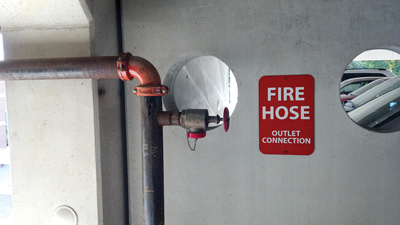 |
|
| Photo 1: A Class 1 standpipe is designed for firefighting personnel only, as it is equipped with a two-and-a-half-inch outlet. Photo by Mark van der Feyst
|
Standpipe systems provide ways to deliver water from one area of a structure to another so that responders can fight fire, while at the same time shortening the length of the supply and attack lines. Standpipes can be intricate or simple systems, but the result is the same: water delivery. These systems are most commonly vertical, but they can be horizontal.
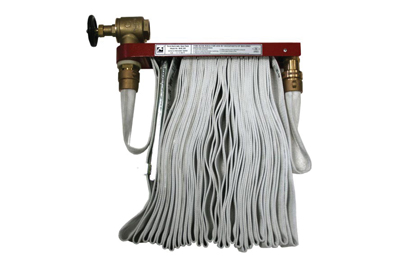 |
|
| Photo 2: A Class 2 standpipe – accompanied by 100-feet of hoseline – is intended for use by building occupants only. Photo by Mark van der Feyst Advertisement
|
We tend to think of highrise buildings when we mention standpipe systems, but many types of buildings and facilities, both outdoor and indoor, have standpipe systems, including parking garages, shopping malls, warehouses, bridges, tunnels and large outdoor yards. I remember back in my engineering days with SimplexGrinnell designing several standpipe systems, for Weyerhaeuser in West Virginia for its outdoor yard – in which it stored all the incoming trees used for making oriented strand board sheets – for Dupont in Parkersburg, W. Va., for its two-storey building that housed a Teflon process machine, and for a state prison in Pennsylvania.
There are four types of standpipe but just one of them is a wet system (the other three are dry systems).
A wet system has water in the pipe at all times, supplied by a water source. The pressure in the system is constantly maintained.
One type of dry system is an automatic dry standpipe; in this case, air is always stored inside the standpipe at a constant pressure. When a hose valve is opened, the air escapes, allowing the water to enter into the standpipe system.
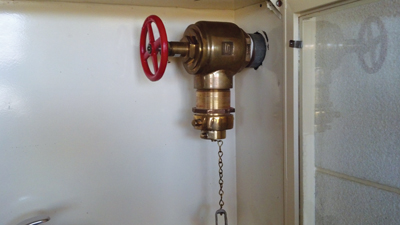 |
|
| Photo 3: A variation on the Class 3 standpipe; it has only one valve, but can supply either a two-and-a-half-inch hose or a one-and-a-half-inch hose. Photo courtesy National Firefighting Manufacturing FZCO |
In a semi-automatic dry standpipe, air is stored inside the pipes, which can be pressurized or not pressurized. Once an actuation device – such as a manual pull station or an electrical switch – is activated, water enters the system.
The third type of a dry standpipe system is a manual dry standpipe. In this type of system, pipes feed the system with no air or water in them. A fire apparatus must be used to supply the water through the standpipe.
There are three classes of standpipe found within buildings: Class 1, Class 2 and Class 3.
A Class 1 standpipe is designed for firefighting personnel only, as it is equipped with a two-and-a-half-inch, or 65-millimetre, outlet (see photo 1). This outlet can be in a stairwell, in a cabinet, in the hallway or standing alone by an I-beam in an open area. The outlets provided with this class of standpipe can vary in design; some will have a pressure-reducing device or valve attached to help regulate the discharged pressure from the system.
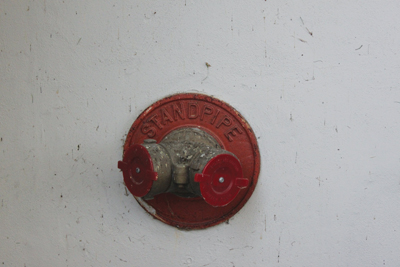 |
|
| Photo 4: The fire department connection will be labelled Standpipe System above the two outlets, making it easy for firefighters to distinguish between the standpipe system and the sprinkler system, if there is one. Photo by Mark van der Feyst
|
A Class 2 standpipe is designed for use by building occupants only (see photo 2). This standpipe system houses a 100-foot, or 30 metre, hoseline of one-and-a-half-inch, or 38 millimetre, hose attached to a reduced standpipe outlet. The Class 2 system allows occupants to safely escape the area of concern using the hose to provide a safe passageway by protecting the exit route. It is not designed for fighting fires. Firefighters could hook up to this type of standpipe, but doing so would involve undoing the occupant hose system and exposing the standpipe’s two-and-a-half-inch, or 65 millimetre, outlet.
A Class 3 standpipe is a hybrid version of Classes 1 and 2. It contains an exposed two-and-a-half-inch outlet, as well as occupant hose. This type of standpipe system is very common in buildings in which occupant load is consistent. In photo 3, you can see a variation of a Class 3 standpipe. It has only one valve, but there is an option to supply either a two-and-a-half-inch or a one-and-a-half-inch hose.
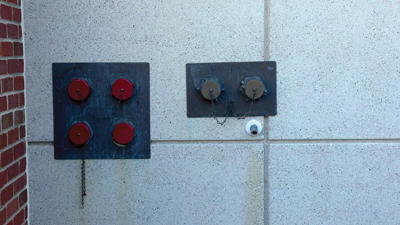 |
|
| Photo 5: Some buildings have separate fire department connections for each type of system – be it standpipe or sprinkler – in the building. Photo by Mark van der Feyst
|
An important area of concern for the fire department is supplying the standpipe system or tying into it with the fire apparatus. There will be a fire department connection (FDC) on the outside of the building for the standpipe system. The FDC allows firefighters to provide or add to the water supply and overall pressure inside the system. When connecting to the FDC, it is important to ensure that no debris is inside the FDC female couplings. Finding debris inside the coupling is common: the FDC is generally fairly close to the ground and kids often stuff things inside the pipe for no apparent reason. The FDC will be labelled Standpipe System immediately above the two outlets (see photo 4). This label lets you know which system to tie into, as there could also be a sprinkler system in the building. Sometimes there are separate FDCs for each type of system and sometimes there are blended FDCs for all of the systems (see photos 5 and 6).
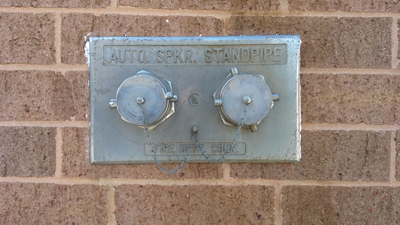 |
|
| Photo 6: Other buildings have a blended fire department connection, which contains outlets for both the sprinkler system and the standpipe system. Regardless, the connection will be labelled. Photo by Mark van der Feyst
|
Be sure to gradually supply the water or increase the pressure inside the system. Standpipe systems are series of pipes that sit there and wait for use. They are sometimes filled with water or air and, after years of inactivity, they can deteriorate. Creating a water hammer in the standpipe system will only allow any deteriorated pipes, pipe couplings or standpipe valves to malfunction, causing more problems.
Next month we will examine the standpipe toolkit that should be assembled ahead of time and brought with the highrise kit or apartment pack.
Mark van der Feyst is a 13-year veteran of the fire service. He works for the City of Woodstock Fire Department in Ontario. Mark instructs in Canada, the United States and India and is a local-level suppression instructor for the Pennsylvania State Fire Academy and an instructor for the Justice Institute of B.C. E-mail Mark at Mark@FireStarTraining.com
Print this page